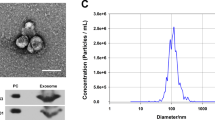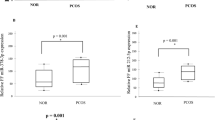Abstract
Purpose
Decreased ovarian reserve function is mainly characterized by female endocrine disorders and fertility decline. Follicular fluid (FF) exosomal microRNAs (miRNAs) have been shown to regulate the function of granulosa cells (GCs). The present study explored differentially expressed miRNAs (DEmiRNAs) in patients with diminished ovarian reserve (DOR).
Methods
FF was collected from 12 DOR patients and 12 healthy controls. DEmiRNAs between the two groups were identified and analyzed using high-throughput sequencing technology and validated by real-time quantitative PCR (RT-qPCR).
Results
A total of 592 DEmiRNAs were identified using high-throughput miRNA sequencing, of which 213 were significantly upregulated and 379 were significantly downregulated. The sequencing results were further validated by RT-qPCR. These DEmiRNA target genes were mainly involved in the cancer pathway, phosphoinositide 3-kinase (PI3K)/protein kinase B (AKT) signaling pathway, regulation of actin cytoskeleton signaling pathway, and biological processes related to protein binding, nucleoplasm, cytoplasm, and cell membrane.
Conclusion
FF exosomal miRNAs are significantly differentially expressed in DOR patients versus non-DOR patients, underscoring their crucial role in regulating the pathogenesis of DOR.




Similar content being viewed by others
Data Availability
Data will be made available to the editors of the journal for review or query upon request.
References
World Health Organization. WHO Team Sexual and Reproductive Health and Research Infertility Prevalence Estimates 1990-2021. World Health Organization. 2024. https://www.who.int/health-topics/infertility. Accessed 9 Nov 2023.
Ata B, Seyhan A, Seli E. Diminished ovarian reserve versus ovarian aging: overlaps and differences. Curr Opin Obstet Gynecol. 2019;31(3):139–47. https://doi.org/10.1097/GCO.0000000000000536.
Pastore LM, Christianson MS, Stelling J, Kearns WG, Segars JH. Reproductive ovarian testing and the alphabet soup of diagnoses: DOR, POI, POF, POR, and FOR. J Assist Reprod Genet. 2018;35(1):17–23. https://doi.org/10.1007/s10815-017-1058-4.
Tang MK, Wong AS. Exosomes: emerging biomarkers and targets for ovarian cancer. Cancer Lett. 2015;367(1):26–33. https://doi.org/10.1016/j.canlet.2015.07.014.
Boon RA, Vickers KC. Intercellular transport of microRNAs. Arterioscler Thromb Vasc Biol. 2013;33(2):186–92. https://doi.org/10.1161/ATVBAHA.112.300139.
Esteller M. Non-coding RNAs in human disease. Nat Rev Genet. 2011;12(12):861–74. https://doi.org/10.1038/nrg3074.
Sang Q, Yao Z, Wang H, Feng R, Wang H, Zhao X, et al. Identification of microRNAs in human follicular fluid: characterization of microRNAs that govern steroidogenesis in vitro and are associated with polycystic ovary syndrome in vivo. J Clin Endocrinol Metab. 2013;98(7):3068–79. https://doi.org/10.1210/jc.2013-1715.
Yang X, Zhou Y, Peng S, Wu L, Lin HY, Wang S, et al. Differentially expressed plasma microRNAs in premature ovarian failure patients and the potential regulatory function of mir-23a in granulosa cell apoptosis. Reproduction. 2012;144(2):235–44. https://doi.org/10.1530/REP-11-0371.
Santonocito M, Vento M, Guglielmino MR, Battaglia R, Wahlgren J, Ragusa M, et al. Molecular characterization of exosomes and their microRNA cargo in human follicular fluid: bioinformatic analysis reveals that exosomal microRNAs control pathways involved in follicular maturation. Fertil Steril. 2014;102(6):1751-61.e1. https://doi.org/10.1016/j.fertnstert.2014.08.005.
Revelli A, Delle Piane L, Casano S, Molinari E, Massobrio M, Rinaudo P. Follicular fluid content and oocyte quality: from single biochemical markers to metabolomics. Reprod Biol Endocrinol. 2009May;4(7):40. https://doi.org/10.1186/1477-7827-7-40.
Rodgers RJ, Irving-Rodgers HF. Formation of the ovarian follicular antrum and follicular fluid. Biol Reprod. 2010Jun;82(6):1021–9. https://doi.org/10.1095/biolreprod.109.082941.
Zamah AM, Hassis ME, Albertolle ME, Williams KE. Proteomic analysis of human follicular fluid from fertile women. Clin Proteomics. 2015Mar 3;12(1):5. https://doi.org/10.1186/s12014-015-9077-6.
Nejabati HR, Roshangar L, Nouri M. Follicular fluid extracellular vesicle miRNAs and ovarian aging. Clin Chim Acta. 2023Jan;1(538):29–35. https://doi.org/10.1016/j.cca.2022.11.003.
Valadi H, Ekström K, Bossios A, Sjöstrand M, Lee JJ, Lötvall JO. Exosome-mediated transfer of mRNAs and microRNAs is a novel mechanism of genetic exchange between cells. Nat Cell Biol. 2007Jun;9(6):654–9. https://doi.org/10.1038/ncb1596.
Kosaka N, Iguchi H, Yoshioka Y, Takeshita F, Matsuki Y, Ochiya T. Secretory mechanisms and intercellular transfer of microRNAs in living cells. J Biol Chem. 2010;285(23):17442–52. https://doi.org/10.1074/jbc.M110.107821.
Zhang P, Wang J, Lang H, Wang W, Liu X, Liu H, et al. MicroRNA-205 affects mouse granulosa cell apoptosis and estradiol synthesis by targeting CREB1. J Cell Biochem. 2019;120(5):8466–74. https://doi.org/10.1002/jcb.28133.
Cao R, Wu W, Zhou X, Liu K, Li B, Huang X, et al. Let-7g induces granulosa cell apoptosis by targeting MAP3K1 in the porcine ovary. Int J Biochem Cell Biol. 2015;68:148–57. https://doi.org/10.1016/j.biocel.2015.08.011.
Xiao Y, Peng X, Peng Y, Zhang C, Liu W, Yang W, et al. Macrophage-derived extracellular vesicles regulate follicular activation and improve ovarian function in old mice by modulating local environment. Clin Transl Med. 2022Oct;12(10):e1071.https://doi.org/10.1002/ctm2.1071
Donadeu FX, Schauer SN, Sontakke SD. Involvement of miRNAs in ovarian follicular and luteal development. J Endocrinol. 2012Dec;215(3):323–34. https://doi.org/10.1530/JOE-12-0252.
Fiedler SD, Carletti MZ, Hong X, Christenson LK. Hormonal regulation of MicroRNA expression in periovulatory mouse mural granulosa cells. Biol Reprod. 2008;79(6):1030–7. https://doi.org/10.1095/biolreprod.108.069690.
Chen B, Xu P, Wang J, Zhang C. The role of MiRNA in polycystic ovary syndrome (PCOS). Gene. 2019;706:91–6. https://doi.org/10.1016/j.gene.2019.04.082.
Woo I, Christenson LK, Gunewardena S, Ingles SA, Thomas S, Ahmady A, et al. Micro-RNAs involved in cellular proliferation have altered expression profiles in granulosa of young women with diminished ovarian reserve. J Assist Reprod Genet. 2018Oct;35(10):1777–86. https://doi.org/10.1007/s10815-018-1239-9.
Deswal R, Dang AS. Dissecting the role of micro-RNAs as a diagnostic marker for polycystic ovary syndrome: a systematic review and meta-analysis. Fertil Steril. 2020Mar;113(3):661-669.e2. https://doi.org/10.1016/j.fertnstert.2019.11.001.
Schneider C, Setty M, Holmes AB, Maute RL. L and is down-regulated in B-cell lymphomas. Proc Natl Acad Sci U S A. 2014Jun 3;111(22):8185–90. https://doi.org/10.1073/pneslieCS,MussolinL,RosolenA,Dalla-FaveraR,BassoK.MicroRNA28controlscellproliferationas.1322466111.
Bartolucci AF, Uliasz T, Peluso JJ. MicroRNA-21 as a regulator of human cumulus cell viability and its potential influence on the developmental potential of the oocyte. Biol Reprod. 2020Jun 23;103(1):94–103. https://doi.org/10.1093/biolre/ioaa058.
Maidarti M, Anderson RA, Telfer EE. Crosstalk between PTEN/PI3K/Akt signalling and DNA damage in the oocyte: implications for primordial follicle activation, Oocyte Quality and Ageing. Cells. 2020Jan 14;9(1):200. https://doi.org/10.3390/cells9010200.
Li L, Shi X, Shi Y, Wang Z. The signaling pathways involved in ovarian follicle development. Front Physiol. 2021Sep;20(12):730196. https://doi.org/10.3389/fphys.2021.730196.
Reddy P, Shen L, Ren C, Boman K, Lundin E, Ottander U, et al. Activation of Akt (PKB) and suppression of FKHRL1 in mouse and rat oocytes by stem cell factor during follicular activation and development. Dev Biol. 2005May 15;281(2):160–70. https://doi.org/10.1016/j.ydbio.2005.02.013.
Adhikari D, Liu K. Molecular mechanisms underlying the activation of mammalian primordial follicles. Endocr Rev. 2009Aug;30(5):438–64. https://doi.org/10.1210/er.2008-0048.
Coticchio G, Dal Canto M, Mignini Renzini M, Guglielmo MC, Brambillasca F, Turchi D, et al. Oocyte maturation: gamete-somatic cells interactions, meiotic resumption, cytoskeletal dynamics and cytoplasmic reorganization. Hum Reprod Update. 2015;21(4):427–54. https://doi.org/10.1093/humupd/dmv011.
Chen L, Ni Z, Cai Z, Cheng W, Sun S, Yu C, et al. The mechanism exploration of follicular fluids on granulose cell apoptosis in endometriosis-associated infertility. Biomed Res Int. 2021;2021:6464686. https://doi.org/10.1155/2021/6464686.
Deb B, Uddin A, Chakraborty S. miRNAs and ovarian cancer: an overview. J Cell Physiol. 2018;233(5):3846–54. https://doi.org/10.1002/jcp.26095.
Frisk NLS, Sørensen AE, Pedersen OBV, Dalgaard LT. Circulating microRNAs for Early Diagnosis of Ovarian Cancer: A Systematic Review and Meta-Analysis. Biomolecules. 2023;13(5):871. https://doi.org/10.3390/biom13050871.
Wei L, He Y, Bi S, Li X, Zhang J, Zhang S. miRNA-199b-3p suppresses growth and progression of ovarian cancer via the CHK1/E-cadherin/EMT signaling pathway by targeting ZEB1. Oncol Rep. 2021;45(2):569–81. https://doi.org/10.3892/or.2020.7895.
Srivastava A, Moxley K, Ruskin R, Dhanasekaran DN, Zhao YD, Ramesh R. A Non-invasive liquid biopsy screening of urine-derived exosomes for miRNAs as biomarkers in endometrial cancer patients. AAPS J. 2018;20(5):82. https://doi.org/10.1208/s12248-018-0220-y.
Vasilatou D, Sioulas VD, Pappa V, Papageorgiou SG, Vlahos NF. The role of miRNAs in endometrial cancer. Epigenomics. 2015;7(6):951–9. https://doi.org/10.2217/epi.15.41.
Hill M, Tran N. miRNA interplay: mechanisms and consequences in cancer. Dis Model Mech. 2021;14(4). https://doi.org/10.1242/dmm.047662
Gebremedhn S, Gad A, Ishak GM, Menjivar NG, Gastal MO, Feugang JM, et al. Dynamics of extracellular vesicle-coupled microRNAs in equine follicular fluid associated with follicle selection and ovulation. Mol Hum Reprod. 2023;29(4). https://doi.org/10.1093/molehr/gaad009.
Funding
We gratefully acknowledge all of the funding sources and all study participants. This work was supported by grants from the National Natural Science Foundation of China, Grant/Award Number: 82074479; Special Foundation of Clinical Medicine of Jiangsu Provincial Bureau of Science and Technology,Grant/Award Number: ZT202107.
Author information
Authors and Affiliations
Contributions
Ying Xie and Juan Chen: investigation, writing—original draft; Kailu Liu, Jingyu Huang and Yaqiong Zeng: visualization, data curation; Mengya Gao, Yu Qian, Li Liu: validation analysis, Yong Tan and Xiaowei Nie: project administration, funding acquisition.
Corresponding authors
Ethics declarations
Ethics approval
The Jiangsu Provincial Hospital of Traditional Chinese Medicine’s Ethics Committee examined and authorized this study (Approval No. 2022NL-200–03). This study was carried out in accordance with ethics committee permission and the Declaration of Helsinki.
Conflict of interest
The authors declare no competing interests.
Additional information
Publisher's Note
Springer Nature remains neutral with regard to jurisdictional claims in published maps and institutional affiliations.
Rights and permissions
Springer Nature or its licensor (e.g. a society or other partner) holds exclusive rights to this article under a publishing agreement with the author(s) or other rightsholder(s); author self-archiving of the accepted manuscript version of this article is solely governed by the terms of such publishing agreement and applicable law.
About this article
Cite this article
Xie, Y., Chen, J., Liu, K. et al. Differential expression of follicular fluid exosomal microRNA in women with diminished ovarian reserve. J Assist Reprod Genet 41, 1087–1096 (2024). https://doi.org/10.1007/s10815-024-03037-5
Received:
Accepted:
Published:
Issue Date:
DOI: https://doi.org/10.1007/s10815-024-03037-5




